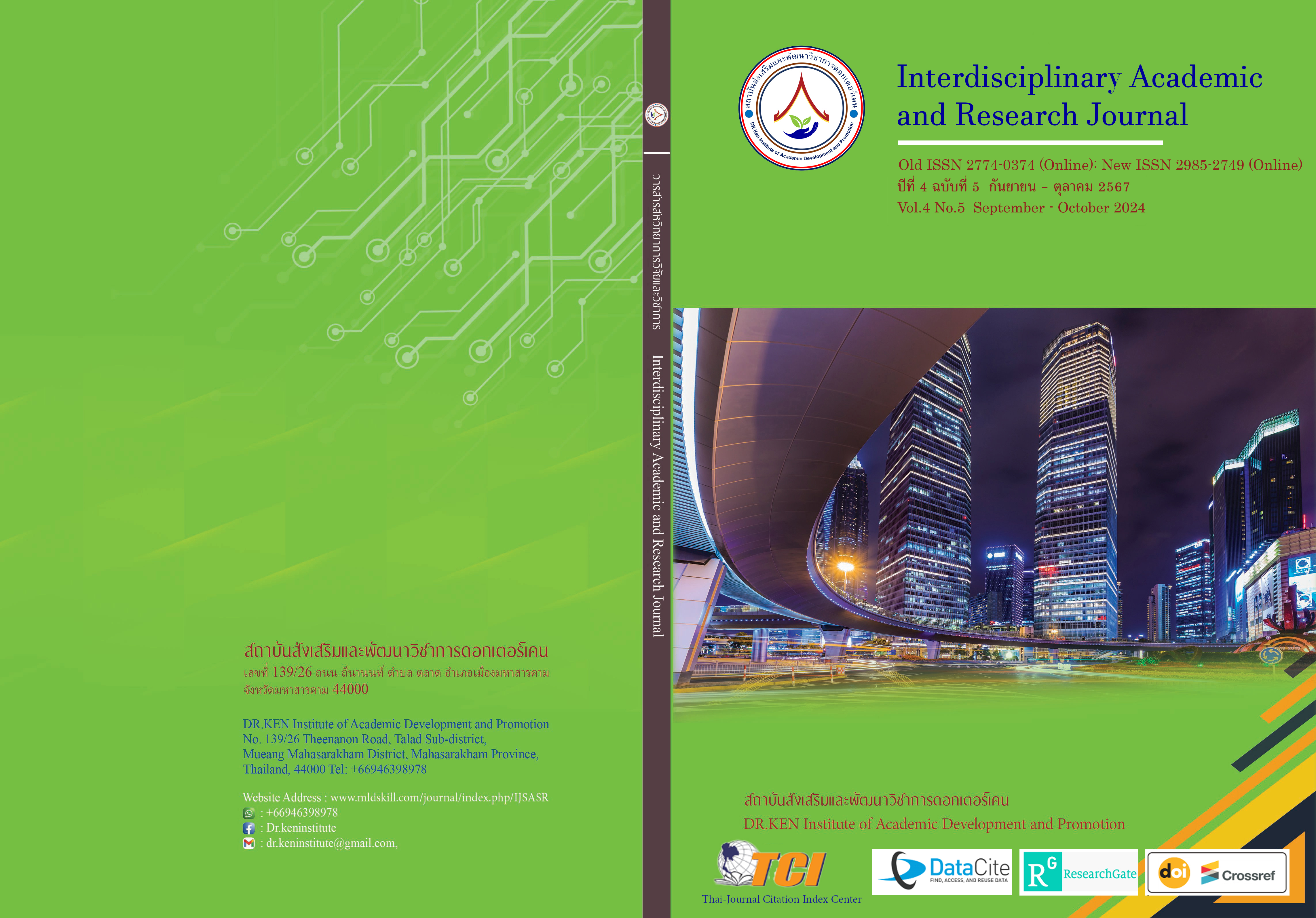Confirmatory Factor Analysis in Behavioral Science and Social Science Research
DOI:
https://doi.org/10.60027/iarj.2024.280735Keywords:
Confirmatory Factor Analysis; , Behavioral Science and Social Science ResearchAbstract
Background and Aims: Confirmatory Factor Analysis is a widely used statistical method in the research of behavioral science, and social science, it aims to explore and identify common factors that can explain the relationship between observed variables.
Methodology: This study is a literature review study related to the study of Confirmatory Factor Analysis (CFA). The content analysis was conducted and the descriptive presentation was presented according to the important issues.
Results: The result is to reduce the observed variables by creating new ones with common factors. In behavioral science and social science research, confirmatory factor analysis is used to confirm a measurement model with empirical data, where the researcher has a theory, and a measurement model, and knows in advance how many factors formed from variables. This information will be taken from the review of related literature, theories, documents, and research. A clear conceptual framework will be defined. A measurement model will be created with known names and numbers of factors and variables. Relationships between factors and observed variables or indicators are determined in advance before proceeding with data analysis of measurement models, such as transformational leadership, instructional leadership, strategic leadership, visionary leadership, innovative leadership, educational leadership, ethical leadership, creative leadership, and transcendental leadership.
Conclusion: The findings highlight the importance of confirmatory factor analysis in behavioral and social science research, in which predefined measurement models based on theory and literature are validated using empirical data. This process clarifies the relationships between leadership types and observed variables, ensuring that the conceptual framework accurately represents the underlying factors.
References
กัลยา วานิชบัญชา.(2546). การวิเคราะห์สถิติชั้นสูงด้วย SPSS for Windows. พิมพ์ครั้งที่ 3. กรุงเทพฯ : ธรรมสาร.
คมกฤช พรหมฉิน. (2560). การวิเคราะห์องค์ประกอบเชิงยืนยันของภาวะผู้นำเชิงกลยุทธ์ ในศตวรรษที่ 21 ของผู้บริหารสถานศึกษา. วิทยานิพนธ์ครุศาสตร์มหาบัณฑิต สาขาบริหารการศึกษา มหาวทิยาลยัราชภัฏรําไพพรรณี
จิรวัฒน์ วงษ์คง. (2563). การวิเคราะห์องค์ประกอบเชิงยืนยันทักษะชีวิตของผู้เรียนสังกัดสำนักงานเขตพื้นที่การศึกษามัธยมศึกษา เขต 25. วารสารบริหารการศึกษา มหาวิทยาลัยขอนแก่น. 16(2), 102 – 115.
นงลักษณ์ วิรัชชัย. (2542). โมเดลลิสเรล: สถิติวิเคราะห์สำหรับการวิจัย. (พิมพ์ครั้งที่ 3). กรุงเทพฯ: โรงพิมพ์แห่งจุฬาลงกรณ์มหาวิทยาลัย.
นงลักษณ์ วิรัชชัย. (2555). การวิเคราะห์องค์ประกอบเชิงยืนยัน. วารสารวิจัยและพัฒนาหลักสูตร. 2 (1), 68-74.
เพชรน้อย สิงห์ช่างชัย.(2549). หลักการและการใช้สถิติการวิเคราะห์ตัวแปรหลายตัวสำหรับการวิจัยทางการพยาบาล. พิมพ์ครั้งที่ 3. สงขลา : ชานเมืองการพิมพ์
สุนทรพจน์ ดำรงค์พานิช. (2554). โปรแกรม Mplus กับการวิเคราะห์ข้อมูลทางพฤติกรรมศาสตร์และสังคมศาสตร์. มหาสารคาม : มหาวิทยาลัยมหาสารคาม, 2554.
สุภมาศ อังศุโชติ, สมถวิล วิจิตรวรรณา และรัชนีกูล ภิญโญนุวัฒน์. (2557). สถิติวิเคราะห์สำหรับการวิจัยทางสังคมศาสตร์และพฤติกรรมศาสตร์: เทคนิคการใช้โปรแกรม LISREL. พิมพ์ครั้งที่ 4. กรุงเทพฯ; เจริญดีมั่นคงการพิมพ์.
สุวิมล ติรกานันท์. (2553). การวิเคราะห์ตัวแปรพหุในงานวิจัยทางสังคมศาสตร์. กรุงเทพฯ; โรงพิมพ์แห่งจุฬาลงกรณ์มหาวิทยาลัย.
เสรี ชัดแช้ม. (2547). การวิเคราะห์องค์ประกอบเชิงยืนยัน. วารสารวิจัยและวัดผลการศึกษา. 2(1), 15 – 42.
อุไรวรรณ ภูชาดา, ภิญโญ มนูศิลป์ และยุพร ริมชลการ. (2558). การพัฒนาตัวบ่งชี้ภาวะผู้นำเชิงวิสัยทัศน์ของผู้บริหารสถานศึกษาในสังกัดสำนักงานเขตพื้นที่การศึกษาประถมศึกษาภาคตะวันออกเฉียงเหนือ. วารสาร บริหารการศึกษา มหาวิทยาลัยขอนแก่น. 11(1), 57 – 67.
Bollen, K.A.(1989). Structural Equations with Latent Variables. New York: John Wiley & Sons, Inc.
Brown, T. A. (2015). Confirmatory Factor Analysis for Applied Research. 2nd edition. New York, NY: Guilford Publications.
Comrey, A.L., & Lee, H.B.(1992). A first course in factor analysis. Hillsdale, NJ: Erlbaum.
Dragan, D., & Topolšek, D. (2014). Introduction to structural equation modeling: review, methodology and practical applications. The 11th International Conference on Logistics & Sustainable Transport 2014, 19–21 June 2014, Celje, Slovenia, 1–27.
Hair, J., Black, W., Babin, B. Y. A., Anderson, R., & Tatham, R. (2010). Multivariate Data Analysis. 7th edition. New Jersey: Pearson Prentice Hall.
Hoyle, R. H. (2004). Confirmatory factor analysis. In M. Lewis-Beck., & T. Liao (Eds.), Encyclopedia of social science research methods, 1, 169-174.
Kerlinger, F.N., & Lee, H. B. (2000). Foundation of behavioral research. Orlando: Harcourt College Publishers.
Kline, Rex B. (2011). Principles and Practice of Structural Equation Modeling. 3rd edition. The Guilford Press.
Monro, B.H. (2001). Statistical methods for health care research. 4th edition. Philadelphia: W.B. Saunders.
Schermelleh-Engel, K., Moosbrugger, H., & Müller, H. (2003). Evaluating the fit of structural equation models: Test of significance and descriptive goodness-of-fit measures. Methods of Psychological Research - Online, 8(2), 23-74
Schumacker, R.E, & Lomax, R.G. (2010). A Beginner’s Guide to Structural Equation Modeling. 3rd edition. New York; Taylor & Francis Group.
Siphai, S. (2018). Indicators of the Characteristics of Rajabhat University students at the new edge of learning to education 4.0. International Journal of Science and Research (IJSR). 7 (8), 1-10.
Spearman, C. (1904). General Intelligence, Objectively Determined and Measured. The American Journal of Psychology, 15, 201-292. https://doi.org/10.2307/1412107
Stevens, J. (1996). Applied multivariate statistics for the social sciences. 3rd edition. Mahwah, NJ: Lawrence Erlbaum Associates, Publishers.
Tabachnick, B. G., & Fidell, L. S. (2001). Using Multivariate Statistics. Boston: Allyn and Bacon.
Downloads
Published
How to Cite
Issue
Section
License
Copyright (c) 2024 Interdisciplinary Academic and Research Journal

This work is licensed under a Creative Commons Attribution-NonCommercial-NoDerivatives 4.0 International License.
Copyright on any article in the Interdisciplinary Academic and Research Journal is retained by the author(s) under the under the Creative Commons Attribution-NonCommercial-NoDerivatives 4.0 International License. Permission to use text, content, images, etc. of publication. Any user to read, download, copy, distribute, print, search, or link to the full texts of articles, crawl them for indexing, pass them as data to software, or use them for any other lawful purpose. But do not use it for commercial use or with the intent to benefit any business.
















.png)


